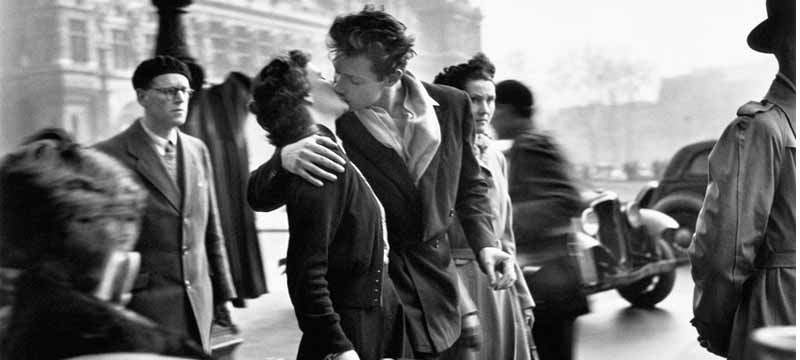From March 5 to May 22, 2022, an exhibition on one of the greatest photographers of the 20th century, Robert Doisneau (Gentilly, 1912 - Montrouge, 1994), is scheduled at the Saint-Bénin Center in Aosta, organized at the initiative of the Cultural Heritage Department of the Autonomous Region of Valle d’Aosta. Entitled simply Robert Doisneau and curated by Gabriel Bauret, it stands as a major retrospective on the celebrated French photographer.
“The very select images that curator Gabriel Bauret has chosen for this exhibition,” says Director of Exhibition Activities Daria Jorioz, “come from the Atelier Doisneau in Montrouge, in the south of the French capital. They are empathic images that bring the viewer closer, making him a participant and not just a spectator. Robert Doisneau embodies the image of the humanist photographer immersed in the life of his city: he captures its breath, its emotions, its social transformations, he narrates its beauty, its contradictions, the minimal stories that make up its collective history. The French photographer grows up with his city, observes it by taking visual notes, narrates it starting from the street, mirrors himself in the games of children who invent their world, narrates the sometimes rough condition of adults. He always does this with delicacy and grace, sometimes with melancholy, often with a subtly disguised or playfully obvious irony.”
Among the works on display is no shortage of Le Baiser de l’Hôtel de Ville, a famous and iconic image that is considered among the most reproduced in the world. In this famous shot of his, Doisneau was able to capture a magical moment and emotion that are universal. In Montrouge, Doisneau developed and archived his images for over fifty years, and it was there that he passed away in 1994, leaving a legacy of nearly 450,000 negatives. From the same atelier, today his two daughters contribute to the dissemination and popularization of his work, accepting constant requests from museums, festivals and publishing houses.
Born in 1912 in Gentilly, a town in the southern suburbs of Paris, the first stages of Robert Doisneau’s career are marked by a training in lithography, an activity he will quickly abandon in favor of an apprenticeship at the studio of André Vigneau, a photographer who provides him with a window on the art world. This was to be followed, for four years, by an intense collaboration with Renault’s advertising department. Once free of this commitment, Robert Doisneau landed the much coveted status of independent photographer, but his momentum was broken by the war, which nevertheless did not prevent him from continuing to photograph. Immediately after the Liberation of the capital, which he witnesses, he begins a very intense period of commissions for advertising (and in particular for the automobile industry), the press (including the magazines “Le Point” and later “Vogue”) and publishing. In parallel, he pursued his personal projects, which would be the subject of numerous publications, beginning with the work La Banlieue de Paris, which came out in 1949 and was created in collaboration with the writer Blaise Cendrars.
His trajectory also intersected with those of Jacques Prévert and Robert Giraud, whose experience and friendship nourished his photography, as well as with that of the actor and cellist Maurice Baquet, with whom he staged a large number of images. From 1946 his photographs were distributed by the Rapho agency. There he met in particular Sabine Weiss, Willy Ronis, and later Édouard Boubat, who together with him would form an aesthetic current often referred to as “humanist.” In 1983 he was awarded the “Grand Prix national de la photographie,” consecrating an extremely rich and dense body of work. This consecration comes through the countless exhibitions, in France as well as abroad, the incalculable works revisiting his photography from the most varied perspectives and the documentaries dedicated to him. And in Aosta, the Italian public will have the pleasure of approaching the great photographer through no less than 128 of his most beautiful images.
Pictured: a detail of Le Baiser de l’Hôtel de Ville.
 |
| In Aosta, a major retrospective on French photographer Robert Doisneau |
Warning: the translation into English of the original Italian article was created using automatic tools. We undertake to review all articles, but we do not guarantee the total absence of inaccuracies in the translation due to the program. You can find the original by clicking on the ITA button. If you find any mistake,please contact us.